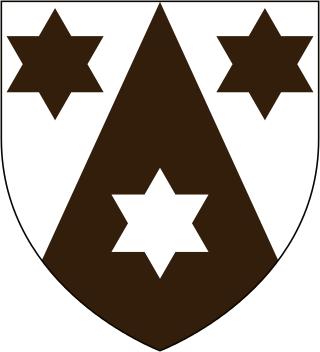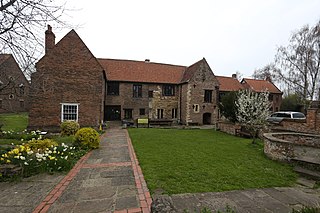
Boston Friary refers to any one of four friaries that existed in Boston, Lincolnshire, England.

Boston Friary refers to any one of four friaries that existed in Boston, Lincolnshire, England.
52°58′18″N0°01′09″W / 52.9717°N 0.0192°W
The Augustinian Friary was founded 1317/18 and was sited near St John's Churchyard in Skirbeck. [1] Land was acquired from Andrew son of Robert atte Gote or Gotere in 1318, John de la Gotere in 1327, John de Moulton and John Leeke in 1342. [2] There were twenty friars here in 1328. [2] It was Surrendered in 1539 to the Bishop of Dover [2] and leased in 1541 to Thomas Browne, but bought by the town in 1544/5 [2] In 1573 the site was leased to Anthony Kime. [2] Today the greater part of the site is covered by the old Union Workhouse. [1]
First Friary 52°58′31″N0°01′36″W / 52.9752°N 0.0266°W
Later Friary 52°58′31″N0°01′32″W / 52.9753°N 0.0256°W
The Carmelites known in medieval England as the White Friars, were established in 1293 originally in Skirbeck, but later at a site off the High Street opposite Doughty Quay, [3] which they bought from John Parleben in 1308, [2] having been granted permission to erect a church by King Edward II. [2] They bought more land in 1315/16. In 1349 Simon Lambert gave them more land, and a year later they received four acres from Sir John de Orreby. [2] Following the Dissolution of the Monasteries, about 1544/5, the town of Boston purchased the White Friars site. [2]
52°58′32″N0°01′22″W / 52.9756°N 0.0227°W
The Dominicans were known in medieval England as the Shod Friars or more commonly the Black Friars. The Friary was founded in 1222. [4] In 1288 their buildings, along with a large area of the town, were burnt during St Botolphs Fair, and in 1290 they were given eight oaks from Sherwood Forest by the King. [2] In 1327 they were given a royal licence to build a subterranean aqueduct from Bolingbroke to their house. [2] The friary was forceably closed in 1539 in the Dissolution of the Monasteries, and in 1540 the land confiscated from the friars was granted to the Duke of Suffolk. [2] The refectory of the Dominican friary is the only part of any of the local friaries still in existence. [4] It is Grade II* listed, and houses the Blackfriars Arts Centre. [5]
52°58′29″N0°01′18″W / 52.9748°N 0.0217°W
The Franciscans were known as the Grey Friars and their house was established at an unknown date prior to 1268. [2] According to Leland, the Franciscans mixed with the Esterlings (European merchants), and many were buried there. Among those was Wisselus de Smallenburg, a merchant from Munster, who died in 1340, and whose grave slab today lies in St Botolph's Church, Boston. [2] The friary was seized in 1539, [6] and valued at 44s. a year. While at first reserved for the King, it was then sold off to the town in 1544/5. [2]

Boston is a market town and inland port in the borough of the same name in the county of Lincolnshire, England. Boston is 160 miles (260 km) north of London, 34 miles (55 km) north-east of Peterborough, 58 miles (93 km) east of Nottingham, 35 miles (56 km) south-east of Lincoln, 71 miles (114 km) south-southeast of Hull and 80 miles (130 km) north-west of Norwich.
Black Friars is an area of Leicester, England, to the west of the city centre.

Blackfriars, Gloucester, England, founded about 1239, is one of the most complete surviving Dominican black friaries in England. Now owned by English Heritage and restored in 1960, it is currently leased to Gloucester City Council and used for weddings, concerts, exhibitions, guided tours, filming, educational events and private hires. The former church, since converted into a house, is a Grade I listed building.

St Andrew's Hall and Blackfriars' Hall or The Halls are a Grade I listed complex of former friary church and convent buildings in the English city of Norwich, Norfolk, dating back to the 14th century. They make up the most complete friary surviving in England. The complex is made up of several flint buildings. The centrepiece is St Andrew's Hall. The halls are now used for conferences, weddings, concerts, beer festivals and meetings. The maximum capacity is 1,200 people. It is one of the Norwich 12 heritage sites.
Dunstable Friary was a Dominican friary in Dunstable, Bedfordshire, England. It was located to the west of Watling Street, between the present-day High Street South and the road that is called Friary Field.

Derby Black Friary, also known as Derby Dominican Priory, or Blackfriars, Derby, was a Dominican priory situated in the town of Derby, England. It was also named in different sources as a friary, monastery and convent, but was officially a priory as it was headed by a prior. The "Black" came from the colour of the mantles worn by the friars of the order.

Whitefriars, also known as the White Friars or The College of Carmelites, Gloucester, England, was a Carmelite friary of which nothing now survives.
Boston Priory was a priory in Boston, Lincolnshire, England.

Ipswich Blackfriars was a medieval religious house of Friars-preachers (Dominicans) in the town of Ipswich, Suffolk, England, founded in 1263 by King Henry III and dissolved in 1538. It was the second of the three friaries established in the town, the first being the Greyfriars, a house of Franciscan Friars Minors, and the third the Ipswich Whitefriars of c. 1278–79. The Blackfriars were under the Visitation of Cambridge.

The Blackfriar is a Grade II* listed public house on Queen Victoria Street in Blackfriars, London.

Beverley Friary is a row of buildings in Beverley, East Riding of Yorkshire, England. The buildings are a Grade II* listed building that since 1984 have been used as a youth hostel. They are thought to be either part of an old Dominican friary, or to have been built on the site of the friary using stone from the site.
The Worcester Blackfriars was a monastery in England, belonging to the Dominican Order. It was founded in 1347 by William Beauchamp, Lord of Elmley. The monastery contained a school of divinity.